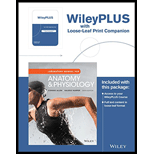
Concept explainers
(a).
To review: The location and function of each connective tissue type in Table 6.7.
Introduction: The connective tissue connects in-between the tissues and organs and also separates them at the same time. The connective tissue has a variety of functions like supports, connects, and binds the tissue and organs. The connective tissue has an extracellular matrix that can bear the stress and protects the tissues.
(b).
To review: The location and function of each connective tissue type in Table 6.8.
Introduction: The connective tissue connects in-between the tissues and organs and also separates them at the same time. There are a variety of connective tissues like dense connective tissue where they are packed mostly with fibers and only a few fibroblasts. The dense connective tissue can be of two types, elastic, dense regular connective tissues, and dense irregular connective tissues.
(c).
To review: The location and function of each connective tissue type in Table 6.9.
Introduction: The cartilage is a special type of connective tissue, where the collagen makes up the extracellular matrix, and frim gelatinous ground substance is embedded with the elastic fibers. The elastic fiber gives elasticity to the cartilage and collagen gives strength to the tissue.
(d).
To review: The location and function of each connective tissue type in Table 6.10.
Introduction: When compared with all the connective tissues, the bones are considered to be the hardest of all the connective tissues. The bone consists of an organized layer of extracellular matrix called lamella. The lamella has collagen fibers, calcium (inorganic salts), and ground substance. The bones can be of compact and spongy depending upon the location.
(e).
To review: The location and function of each connective tissue type in Table 6.11.
Introduction: The blood is also considered to be a connective tissue due to its extracellular matrix present in the plasma. Yet, the fibers of the extracellular matrix are exposed or observed only during an injury. The blood contains white blood cells, red bell cells, plasma, and platelets.
Want to see the full answer?
Check out a sample textbook solution
Chapter 6 Solutions
Laboratory Manual for Anatomy and Physiology, 6e Loose-Leaf Print Companion
 Human Anatomy & Physiology (11th Edition)BiologyISBN:9780134580999Author:Elaine N. Marieb, Katja N. HoehnPublisher:PEARSON
Human Anatomy & Physiology (11th Edition)BiologyISBN:9780134580999Author:Elaine N. Marieb, Katja N. HoehnPublisher:PEARSON Biology 2eBiologyISBN:9781947172517Author:Matthew Douglas, Jung Choi, Mary Ann ClarkPublisher:OpenStax
Biology 2eBiologyISBN:9781947172517Author:Matthew Douglas, Jung Choi, Mary Ann ClarkPublisher:OpenStax Anatomy & PhysiologyBiologyISBN:9781259398629Author:McKinley, Michael P., O'loughlin, Valerie Dean, Bidle, Theresa StouterPublisher:Mcgraw Hill Education,
Anatomy & PhysiologyBiologyISBN:9781259398629Author:McKinley, Michael P., O'loughlin, Valerie Dean, Bidle, Theresa StouterPublisher:Mcgraw Hill Education, Molecular Biology of the Cell (Sixth Edition)BiologyISBN:9780815344322Author:Bruce Alberts, Alexander D. Johnson, Julian Lewis, David Morgan, Martin Raff, Keith Roberts, Peter WalterPublisher:W. W. Norton & Company
Molecular Biology of the Cell (Sixth Edition)BiologyISBN:9780815344322Author:Bruce Alberts, Alexander D. Johnson, Julian Lewis, David Morgan, Martin Raff, Keith Roberts, Peter WalterPublisher:W. W. Norton & Company Laboratory Manual For Human Anatomy & PhysiologyBiologyISBN:9781260159363Author:Martin, Terry R., Prentice-craver, CynthiaPublisher:McGraw-Hill Publishing Co.
Laboratory Manual For Human Anatomy & PhysiologyBiologyISBN:9781260159363Author:Martin, Terry R., Prentice-craver, CynthiaPublisher:McGraw-Hill Publishing Co. Inquiry Into Life (16th Edition)BiologyISBN:9781260231700Author:Sylvia S. Mader, Michael WindelspechtPublisher:McGraw Hill Education
Inquiry Into Life (16th Edition)BiologyISBN:9781260231700Author:Sylvia S. Mader, Michael WindelspechtPublisher:McGraw Hill Education





